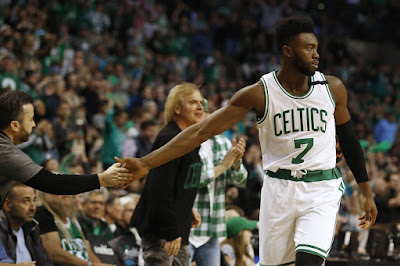In order to make room for Gordon Hayward and his
reported 4-year, $128 million max contract, the Boston Celtics opted to part
ways with shooting guard Avery Bradley. The Celtics traded Bradley, one of the
league’s best perimeter defenders, and a 2019 second-round pick to the Detroit
Pistons in exchange for forward Marcus Morris.
Before President of Basketball Operations Danny Ainge
and his team sent Bradley to Detroit, Boston reportedly shopped Marcus Smart and Jae Crowder in trade talks. When the 2017-18 season concludes, Smart will be
a free agent—albeit a restricted one—like Bradley (unrestricted), but the
popular opinion held that Crowder was the most likely to be moved because he
plays small forward, the same position as the newly-signed All-Star forward Hayward,
Jaylen Brown and Jayson Tatum, the No. 3 overall pick from June’s NBA Draft.
That logic was flawed in many aspects. As evidenced by the 2017 Finals, the NBA
is becoming a positionless league—a sentiment echoed by Celtics head coach Brad
Stevens.
“I don’t have the five positions anymore,” Stevens said. “It may be as simple as three positions now, where you’re either a
ball-handler, a wing or a big.”
By Stevens’ definition, Crowder is a wing—one who is
fully capable of starting alongside Hayward. Crowder’s contract—which pays him
$6.7 million this season, $7.3 million in 2018-19 and $7.8 million in
2019-20—is one of the best in the league and makes him an asset worth holding
onto. Furthermore, the 6’9” 27-year-old remains Boston’s top defensive option
against Cleveland Cavaliers superstar LeBron James.
The Celtics realistically had no shot of re-signing
Bradley in the summer of 2018. They just inked Hayward to a massive deal—a
summer after signing Al Horford to a monster contract—and still need to pay
Isaiah Thomas, a free agent in 2018 who averaged 28.9 points per game last
season and finished 5th in MVP voting. Teams, including the Pistons,
will likely offer Bradley a lucrative, long-term deal, perhaps in the $25
million (annual) range, a contract the Celtics will not be able to match.
Even if the Celtics could fit Bradley in the team’s
cap, it’d be senseless to throw massive amount of money at the guard who has
sit his ceiling as a player. Not when his understudy Smart, 23 and three years
younger than Bradley, can do many of the same things defensively and is still
evolving on offense. Smart took a big leap this past season, elevating his
scoring and ball distribution on offense, while also improving his off-ball
guarding and one-on-one defense.
Assuming Crowder starts next to Hayward and Horford
in the frontcourt and Smart continues to be the first guy off the bench for the
Celtics, Jaylen Brown is set to become a permanent member of Boston’s starting-five.
Brown played much better as a starter, averaging 9.5 points in 20 starts and
reaching double-figures in scoring 10 times. Brown, who saw in uptick in
minutes as the season wound down and even managed to be a part of the Celtics’
playoff rotation, has as much upside as any player from the 2016 NBA Draft
Class. And while the Summer League is hardly a preview of things to come, it’s
impossible to ignore Brown’s dominance in the exhibition contests in Salt Lake
City. In the summer league games in Utah, Brown averaged 17.5 points and 10.5
rebounds per game.
 |
| Jaylen Brown looks to build upon a strong rookie season. (Winslow Townson/AP) |
Brown’s insertion into the starting unit also opens up more playing time at the wing positions to rookie Jayson Tatum and the newly-acquired Marcus Morris, a tweener forward who last season averaged 14 points and 4.6 rebounds per game on 42 percent shooting from the field and 33.3 percent from three-point territory.
The 6’9” Morris is not nearly the player Bradley is,
but he provides the Celtics with two things the often-injured Bradley did not:
elite durability and a lengthy defender to guard LeBron. Morris has played in
77 or more games in each of the past five seasons and no player guarded LeBron
more effectively than Morris in the 2015-16 regular season.
One under the radar positive about Marcus Morris? Durability. Here's his games played totals over last 5 seasons:— Brian Robb (@CelticsHub) July 7, 2017
77
82
81
80
79
According to ESPN.com’s Tom Haberstroh, James
averaged just 20.5 points per 100 possessions when defended by Morris that
season—much lower than his 36.5 points per 100 possessions average on the
season.
 |
| LeBron James has words with Marcus Morris, then a member of the Pistons. (USA Today Sports/Tim Fuller) |
While it may be tough for the Celtics to wave goodbye
to Bradley, who became a solid role player under former head coach Doc Rivers
before ultimately becoming a First-Team All-Defense member (2015-16) and
reliable offensive player (16.3 points per game in 2016-17) under Stevens, he
was the odd man out after a trade became inevitable following the Hayward
signing.
The Celtics were never going to get equal value for Bradley—not when it became obvious they were looking to deal the guard before he hit free agency—but acquiring another guy for Stevens to throw at LeBron on defense is hardly a major loss. And while Bradley’s tough-nosed defense and underrated shot-making ability will be certainly missed, especially as the Celtics’ newcomers take time to jell with their teammates, his departure opens the door for Brown to potentially become a star, something Bradley will never be.
No comments:
Post a Comment